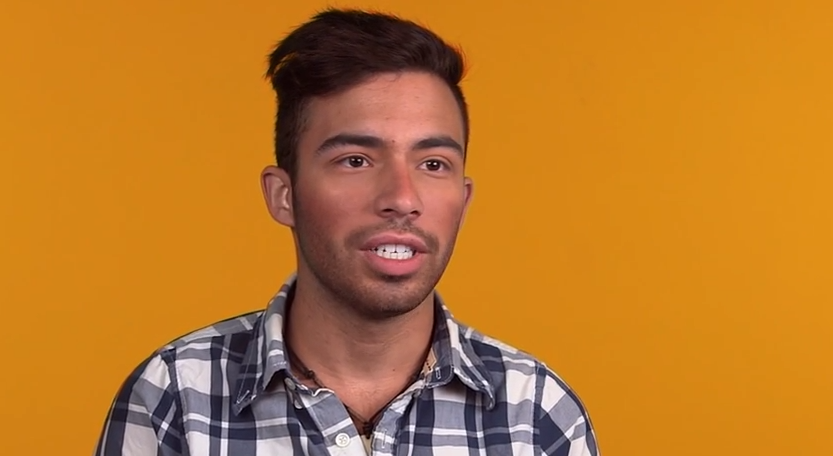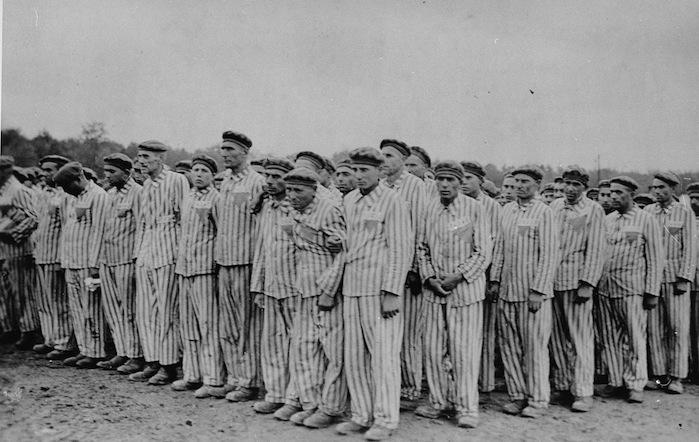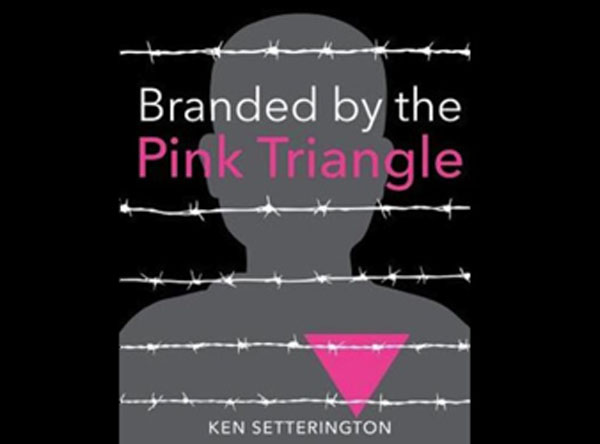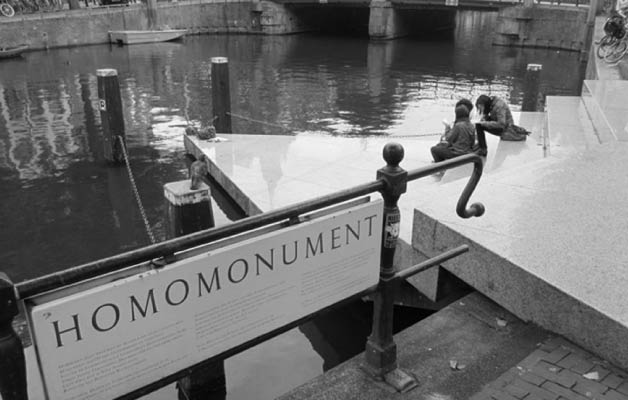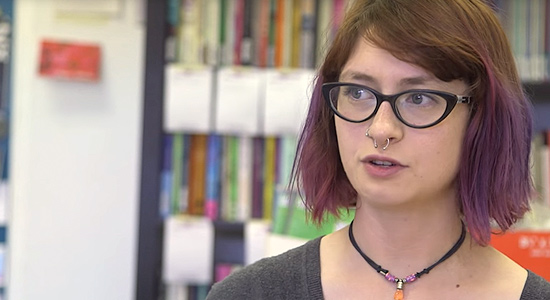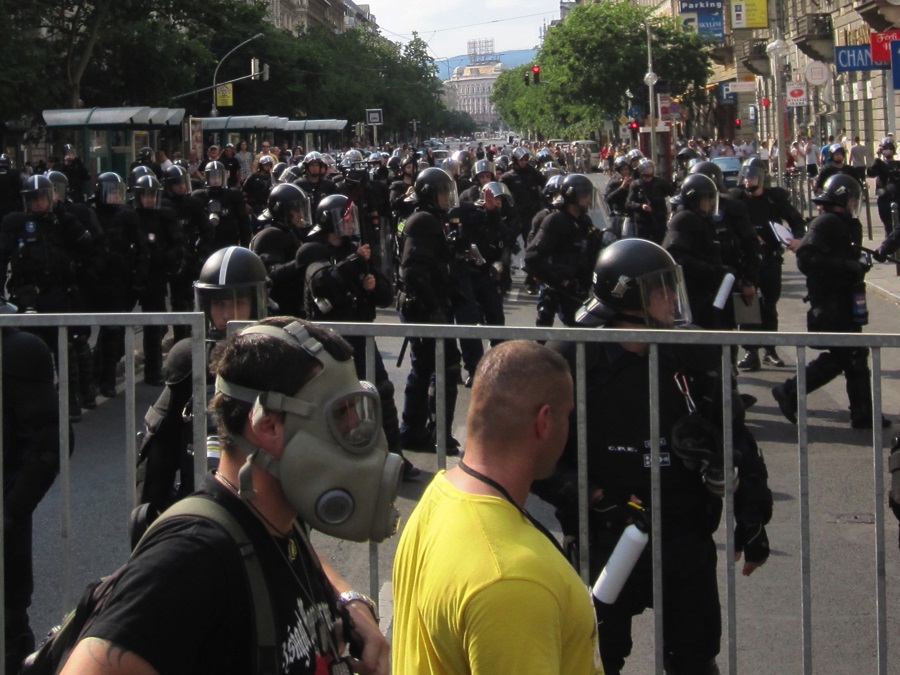Educator Tools

 Ask yourself:
Ask yourself:
- The Nazis rejected any form of homosexuality. Was taking action against this position a danger for homosexuals?
- Why might some people become hateful to those who are homosexual? What action might be taken to combat homophobia?
This page provides you with opportunities to consider Nazi views of homosexual men who were sent to concentration camps because they were considered inferior. The pink triangle, sewn onto the left breast of prison uniforms, became the symbol of persecution for gay men in Nazi Germany and today is recognized as a symbol of both remembrance and celebration. The actions in this chapter invite you to discuss issues connected to homophobia and prejudice and also explore facts connected to those who were “branded” by the pink triangle.
This really happened
Up until the middle of the 1930’s, Germany was considered to be one of the most sexually liberal and accepting countries in the world. When the Nazis took power in Europe, gay men were harassed and labeled as “inferior”.
The Nazi Party did not need to create new laws to prohibit homosexual behaviour. Paragraph 175 was a law against homosexuality that prohibited sex between men. Since the law was already in existence, all the Nazis had to do was enforce it. Paragraph 175 dated back to 1871 when the King of Prussia united various kingdoms into one German state. A new constitution was established. Paragraph 175 stated: “a man who commits indecency with another man, or allows himself to be misused indecently, will be punished with prison.”
Pink became the color of persecution for gay men in Nazi Germany. Those who identified as homosexuals had a pink triangle sewn onto the left breast of their prison uniforms, just as the yellow Star of David was sewn onto those of the Jews. Though drawn from the terrifying period of gay history, the pink triangle today can be recognized as a symbol of remembrance and celebration.
ACTION 1
Discuss
Let’s talk about…Homosexuality, Prejudice and Discrimination
Form groups to discuss issues connected to homophobia and prejudice.
A. You will need a single die. Each player in turn will roll the die and whatever number appears, that is his or her assigned topic listed below to discuss. You will offer your opinion on one of the topics, by sharing your reactions, making connections, asking questions. Once completed, another person rolls the die and discusses the corresponding topic. Note: it is ok if two players discuss the same topic. If someone rolls a six they can choose a topic of choice.
B. The activity is repeated. This time, the group members contribute by having a conversation about the topic. There is no time limit. Alternatively, the group can choose one topic to focus attention on:
- There is nothing wrong with men who choose to wear pink clothing.
- Having a GSA (Gay Straight Alliance) in the school is helpful.
- Every country should legalize gay marriage.
- I know a story about a homophobic incident.
- I have a strong reaction when I hear someone using the word ‘faggot’.
- Choose a topic.
ACTION 2
Do
The Nazis views of Homosexuality
The persecution of homosexuals was just a small part of Hitler’s plan to strengthen the Aryan race. The Aryan or ‘Nordic’ race was proclaimed biologically superior to all others according to Hitler’s regime. The Nazis believed that discipline must be exercised at all costs in order to maintain power. Homosexual relationships were considered vulgar, perverted crimes. The following outlines the Nazi position on homosexuality in response to Paragraph 175.
“It is not necessary that you and I live, but it is necessary that German people live. And it can only live if it can fight, life means fighting. And it can only fight if it maintains its masculinity. It can only maintain its masculinity if it exercises discipline, especially in matters of love. Free love and deviance are undisciplined. Therefore, we reject you, as we reject anything that hurts our nation. Anyone who thinks of homosexual love is our enemy. We reject anything which emasculates our people and makes it a plaything for our enemies, for we know that life is a fight, and it is madness to think that men will ever embrace fraternally. Natural history teaches us the opposite. Might makes right. The strong will always win over the weak. Let us see to it that we can once again become strong! But this we can achieve only in one way—the German people must once again learn how to exercise discipline. We therefore reject any form of lewdness, especially homosexuality, because it robs us of our last chance to free our people from the bondage which now enslaves it.”
~Richard Plant, The Pink Triangle, p. 50
A. What do you think homosexual men might have done in response to the Nazi position?
B. Was taking action a choice for them?
Answer these questions in writing by having a conversation on paper.
Having a conversation on paper
This activity works best with two or three people, each with a piece of paper. This activity invites you to respond to a topic or issue in writing. Done in silence, the goal of the activity is to write your thoughts in responses to a topic and then share it with another person. That person responds in writing to what you have written. The paper is passed back and forth as if you are having a conversation.
You are encouraged to remain silent as you reflect on the issue, raise questions, make connections, agree or argue the topic.
Upon completion, you and your partner can meet with another pair to share what you have written and discuss the issues in small groups.
ACTION 3
Do
Exploring facts about those who were “Branded” By The Pink Triangle
In his book Branded by the Pink Triangle, author Ken Setterington brings to life the under-told stories of bravery and perseverance of homosexual men who were imprisoned in Nazi concentration camps.
Just the Facts
Ken Setterington, a storyteller, book reviewer, author and librarian did extensive research on the topic of the persecution of homosexuals during the Nazi regime. The following statements that appear in Setterington’s book provide some factual information about those who were branded by the pink triangle. With a partner, decide if each of these statements is TRUE or FALSE.
- Many homosexual men joined the German army, hoping that they would be safe from arrest.
- The Nazis believed that if homosexuality was legalized, there would be fewer German babies and hence a lower birth rate, which would lead to a weaker Germany.
- Lesbians who were arrested and sent to concentration camps wore the pink triangle.
- In many concentration camps, homosexuals were housed apart because the Nazis believed that homosexuality was a disease that could spread to other prisoners.
- Some gay bars remained open during the Olympics held in Berlin in 1936.
- The gay community was not allowed to participate in the memorial services held at concentration camps or at war memorials.
- Even SS Officers who were caught in homosexual acts were put in concentration camps.
- Rosa Winkel was the first lesbian to die in a Buchenwald concentration camp.
- German and other European governments provided the same compensation to homosexuals as was provided to other victims of the Nazi regime who suffered losses.
- There are less than ten known gay Jewish survivors of the Holocaust who suffered losses.
Scroll down to see answers at the end of the chapter.
Getting Better: The Pink Triangle Today
Silence=Death
In the 1970s, the pink triangle was chosen as a pro-gay symbol by activists in the United States. In Nazi Germany, the pink triangle badges identified homosexuals who were considered at the bottom of the camp social system and subjected to degradation and harsh maltreatment. To transform a symbol of humiliation into one of solidarity and resistance, the pink triangle was turned upright (i.e., point at the top) rather than inverted. In the onset of the AIDS epidemic it was considered a symbol of gay pride and liberation.
The Silence=Death Project drew parallels between the Nazi period and the AIDS crisis. The project concerned those who chose not to discuss safer sex and the unwillingness of those to resist government indifference to the cause. The men who created the project declared that “silence about the oppression and annihilation of gay people, then and now, must be broken as a matter of our survival.” The six men who created the Silence=Death Project offered the logo to the protest group ACT UP.
Monuments
1985 – a pink triangle plaque was displayed in Dachau. A memorial sculpture made up of triangles of many different colours had been previously created in the camp. The pink triangle had been excluded.
1987 – the Homomonument was opened in Amsterdam, close to the Anne Frank house. Comprised of pink granite triangle ‘steps’, the monument is one of the largest in the world honouring gay men and women. The Homomonument is meant to “inspire and support gays in their struggle against denial, oppression and discrimination.”
Memorial in Amsterdam commemorating all gay men and lesbians who were killed by the Nazis due to their homosexuality. It consists of three large triangles of pink granite.
Credit: P.H. Davies Homomonument Amsterdam
1989 – in Berlin, a pink granite plaque in the shape of triangle was placed outside a subway station in the area of the city where gay culture was celebrated in the years before the rise of the Nazi regime. The plaque states: “Killed and forgotten, the homosexual victims of National Socialism”.
2008 – the Memorial to Homosexuals Persecuted under Nazism was unveiled in Berlin across the street from Murdered Jews of Europe. Visitors to the monument look inside a small window to watch two alternating videos: either two young men kissing or two women kissing.
According to Ken Setterington, the video and the monument “act as strong reminder that these two young men would certainly have been arrested and probably would have died if they had lived during the Nazi period” (p. 101). The wording on a nearby plaque concludes:
Because of its history, Germany has a special responsibility to actively oppose the violation of gay men’s and lesbians’ human rights. In many parts of the world, people continue to be persecuted for their sexuality: homosexual love remains illegal and a kiss can be dangerous.
With this memorial, the Federal Republic of Germany intends to honor the victims of persecution and murder, to keep alive the memory of injustice, and to create a lasting symbol of opposition to enmity, intolerance, and the exclusion of gay men and lesbians.
LGBTQ+ Awareness and Understanding
Everyone has the right to live freely with all human rights, regardless of their sex and sexual preference. People are born as heterosexuals or homosexuals, and many are bisexual. While a person might be born as one sex they may identify as the other sex. Young people who don’t fit into the standard heterosexual mold often experience painful exclusion and bullying. Some of them even take their own lives because their lives are too difficult and painful. In order to be compassionate and understanding, we must educate ourselves about the different types of people in our world and everyone’s personal challenges.
LGBTQ+ Terminology
https://egale.ca/awareness/glossary-of-terms/
The true north LGBTQ+: Canadian survey on LGBT communities 2017
A Brief LGBTQ Canadian History
LGBTQ2+ apology reflections by the special advisor to the PM:
https://www.youtube.com/watch?v=ZBkkLF8iUJE
The Forum Research poll in 2012, commissioned by the National Post and taken twice … to confirm its accuracy, found that 5% of Canadians identify as lesbian, gay, bisexual or transgender. And contrary to the popular wisdom that the same-sex marriage rate is surprisingly low, the poll found that a third of LGBTQ+ people say they are in a same-sex marriage.
Milestones in the evolution of gay rights
- Homosexuality was decriminalized in Canada in 1969. Before that, individuals who engaged in sexual activity with others of the same sex risked long prison sentences.
- Rights and freedoms in the provinces: In 1977, Quebec became the first province to amend its Charter of Human Rights and Freedoms to prohibit discrimination based on sexual orientation. In the years that followed, all provinces and territories eventually followed suit, Alberta being the last, in 2009.
- Canadian Armed Forces: Sexual orientation was removed as a barrier to enrolment and promotion for military personnel in 1992.
- Hate crimes: Since 1996, the Criminal Code has provided stricter penalties for crimes motivated by hate based on certain personal characteristics, including sexual orientation.
- Spousal recognition: In 1999, the Supreme Court of Canada’s landmark decision in M. v. H. recognized same-sex couples as common-law partners. This was followed by provincial and federal legislation granting same-sex couples benefits and obligations similar to those that apply to other common-law couples.
- Same-sex Marriage: In 2005, Canada legalized same-sex marriage by enacting the Civil Marriage Act. This led to amendments to other statutes granting same-sex couples equal access not only to the civil effects of marriage, but also to those of divorce.
Source: http://www.parl.gc.ca/Content/LOP/ResearchPublications/2013-90-e.htm
The Sad Truth:
From: http://egale.ca/all/backgrounder-lgbtq-youth-suicide/
- 33% of LGB youth have attempted suicide in comparison to 7% of youth in general (Saewyc 2007).
- Over half of GLB students (47% of GB males and 73% of LB females) have thought about suicide (Eisenberg & Resnick, 2006).
- In 2010, 47% of trans youth in Ontario had thought about suicide and 19% had attempted suicide in the preceding year (Scanlon, Travers, Coleman, Bauer, & Boyce, 2010).
- LGBTQ youth are 4 times more likely to attempt suicide than their heterosexual peers (Massachusetts Department of Education, 2009).
ACTION 4
Do
Designing a poster
Following a number of tragic suicides by LGBTQ+ students who were bullied in school, columnist and author Dan Savage, along with his partner uploaded a video to YouTube to inspire hope for LGBTQ+ youth who were facing harassment. The couple spoke openly about the suffering they suffered as teenagers and shared the story how they both came to lead rewarding adult lives. Their video launched the “It Gets Better Project” and initiated a worldwide phenomenon with thousands of videos posted. The campaign provides an opportunity for personal heartfelt support for LGBTQ+ youth everywhere.
Design a poster that features the Pink Triangle for an It Gets Better campaign. It Gets Better
Your posters can be displayed in the classroom, school or in the community to help others understand the significance of the pink triangle as a symbol of remembrance and celebration, liberation and gay pride.
- How will you feature one or more pink triangles in your design?
- Who is your audience?
- How will your poster draw an attention to your audience? What message do you hope your poster will convey to others?
- What words (if any, will your poster have)?
ACTION 5
Discuss
Engaged Response: Taking action against Homophobia
A. Why do people hate?
It is hard to understand why someone might hate someone else because of their differences. Those who identify as LGBTQ+ often get grief from others because of their sexual preferences.
Examine the list of reasons below and rank them in order from #1 (strongest) to #6 (lowest).Once completed, share your list in groups of three or four. Are there any other reasons why you feel someone might be homophobic?
People might be cruel to others who identify themselves as queer because:
___They are afraid of what they don’t know. Someone might feel intimidated.
___They might never have had any close interactions with someone who identifies as queer.
___Religious or cultural beliefs do not condone homosexual lifestyles.
___Some people are taught to hate or distrust what they don’t know or understand.
___People go along with awful things because they need to feel accepted. Peer pressure can influence how we treat others.
___Bigots are often insecure. Insecure people often take out their own anxieties about themselves on others – especially those who are a minority. Being hateful to others gives them power.
B. Triumphing over Haters
Examine the list of strategies below that outline actions someone might take if they are being harassed. Rank the list in order from #1 (strongest) to #6 (lowest).
Then, in small groups, discuss the pros and cons of each strategy.
If someone is being tormented by others because of their sexual identity, they should:
___Ignore the situation
___Talk to a trusted adult
___Confront the issue by fighting back
___Seek professional counseling
___Stick with your friends to approach the tormentor
___Other
ACTION 6
Discuss
GSA
Organizing a Gay-Straight Alliance (GSA) / Respecting Difference Clubs
Dedicated to making schools more inclusive for all students, thousands of Gay-Straight Alliances (GSA) have been established in schools throughout North America. A GSA is a student-initiated and student–run club that provides a safe supportive environment for lesbian, gay, bisexual, transgender, two-spirit, queer, questioning (LGBTQ+) and straight ally youth to meet and discuss sexual orientation and gender issues. Many GSAs function as support groups that provide safety and confidentiality for students struggling with their identity. Some GSAs have a mandate to educate themselves and their broader school community about gender and sexual identity issues.
This activity applies to both schools that have or don’t yet have a GSA*. In groups, discuss the following:
- How familiar are you with GSAs?
- Why are GSAs important?
- What are the benefits of having a GSA in your school?
- What might be some challenges of having a GSA in the school?
- How can straight youth become involved in GSAs.
- What are some significant activities for a GSA to become involved in?
- How might teachers, administrators, families, experts get involved in GSA initiatives?
- What are the ground rules that need to be established to ensure that discussions are safe, confidential and respectful?
- What action plan (projects?) might be developed to make the GSA successful?
- Would you consider being involved in a GSA in your school /community?
Day of Pink is Canada’s 2SLGBTQIA+ youth organization. They offer free workshops, youth forums and educator training across Canada. The International Day of Pink in April is the day we wear pink to stop bullying, discrimination, homophobia & transphobia. (This is not the same as another anti-bullying day, Pink Shirt Day, observed on February 24th) Staff at Day of Pink are always happy to help you start a GSA, organize programming and make spaces safer. Find out more:
Day of Pink Organization
*For more information see GLSEN: Gay, Lesbian 7 Straight Education Network.
ACTION 7
Think
Responding to a Hungarian Demonstration
Read the article below and respond to the following questions:
- How successful was Craig Cowan at capturing the events of this clash?
- What messages was he attempting to convey?
 Artifacts
Artifacts
Artifact › A Hungarian Demonstration
By Craig Cowan
June 18, 2011 – Budapest, Hungary
We chose the left side of the intersection simply because a larger crowd was gathered on the left. It seemed intelligent to assume that the local Hungarians would know the best vantage point, so we followed their lead. Prior in the day I had continuously questioned our Hungarian history professor guide regarding the discrepancy between the Gay Pride committee in Budapest and the Hungarian government. The committee avowed that the Pride Parade would take place whereas I had read that the Hungarian government had refused to grant parade permission. After noticeably avoiding my questioning, I was told by the accompanying University of Toronto history professor, “Don’t go looking for trouble, Craig.” How could asking about the Gay Pride parade and wanting to attend it mean trouble? This confused me even further.
Upon arriving on the thoroughfare on which the parade was supposed to take place that day, two things became palpably obvious. First, something frightfully different than what I had expected was about to take place and second, the parade was seemingly going to occur. The mood on the street was very tense; few people wandered about. One person from our group hurriedly left, advising us that this was not a good place to find ourselves. Hundreds upon hundreds if not thousands of Hungarian riot police, wearing full gas mask protective gear, were filing onto the street and readying themselves. They began positioning themselves on each of the adjoining side streets, blocked and shut down intersections, rushed forcefully up and down sidewalks while continuously paying attention to those of us who still remained on the street. They then commenced clearing all people off of the entire parade route. The street was emptied from side to side.
My remaining friend and I were not sure what to do. As I wanted to stay (the photographer in me wanted pictures), we began to walk the emptying street. The police were systematically ordering people off as they moved along. Those businesses that were not already closed began to close up quickly. Every civilian was forced to make a choice. Either leave the street and the area entirely, or choose to stand on either side of one single designated intersection and watch the pride parade from there. As few spoke English, my understanding came from observation and from interpreting hand gestures. My decision to stay was made definite when a black leather gloved hand with extended finger pointed directly at my friend and I and indicated our two choices. One hand gesture indicated the far off distance, the other pointed to the intersection. We chose the left side.
Had I been more astute and not so overwhelmed by the huge numbers of riot police, I would have noticed more closely that hundreds of riot police stood in front of where I now waited (along what I believed would be the parade route) but also directly behind. The scene directly behind us seemed odd but I did not foresee what it might mean. That quite a few males in the crowd were wearing black bandanas over their faces and still others had actual gas masks around their necks (some actually wearing them already) still did not alert me.
Riot police and metal fences separated the crowd from the parade route. Officers were video taping the crowd. The overall mood seemed calm and peaceful, yet there was a tense anticipation of something. Then, loud music was heard. This triggered an assumption that the parade had begun, off in the distance, up the street, beyond sight. The music set off mayhem. Fists went up into the air and angry rioter chanting began. It was scary: the protestors became angry and violent in appearance. There were lots of them. The music grew louder, the parade got closer. The shouts and fists grew more heated and incensed. My friend and I moved back from the metal barricades, away from where the danger seemed most evident.
There was going to be trouble. It had started. I fully understood it now. The riot police shoved forcefully against the barricade fences and held the line as united protestors tried to push into the parade route. The hollering escalated. Fists thrust higher and more passionately into the air and then, more fences. Suddenly we were caged in on all sides by huge numbers of riot police, their facemasks down now, standing behind interlocking barricade fences. We were kettled! The police were rows deep behind each fence. The protestors went ballistic, threw bottles at the police and jammed up against the fences in every direction. Tear gas was fired in at us. The crowd went frantic, dispersed, and ran wildly as one large group, swarming towards my friend and I. We dodged behind a tree, the crowd parting and racing around it. The police pulled open barricade entry points and stormed in after the rioting protestors.
Things escalated further. The protestors, now kettled (all of us would remain kettled for the next four hours) suddenly realized that the pride parade had been re-routed. It had turned off on a side street two blocks north of us. Rioters now knew that they had been duped into standing at this intersection. Minutes later, the parade passed parallel to our prison, two full city blocks to our west and far out of range of any potential harm. As the world’s media looked in at those kettled, recording the event with cameras, four young men with faces fully visible, proudly displayed large placards that had the Nazi pink triangle symbol and rope nooses displayed on them. Death to homosexuals was the clear message.
Neo-Nazis as well as others had threatened to attack and do bodily harm to the parade’s marchers. Hungarian riot police had prepared for such an attack. The use of the pink triangle made apparent the protestors’ agenda towards homosexuals, their violent actions proved their intent. That neo-Nazis presented themselves at this specific parade doesn’t limit the need for our awareness to the potential full scope of their hatred towards all of those groups historically targeted by Hitler and the Nazis, not only homosexuals.
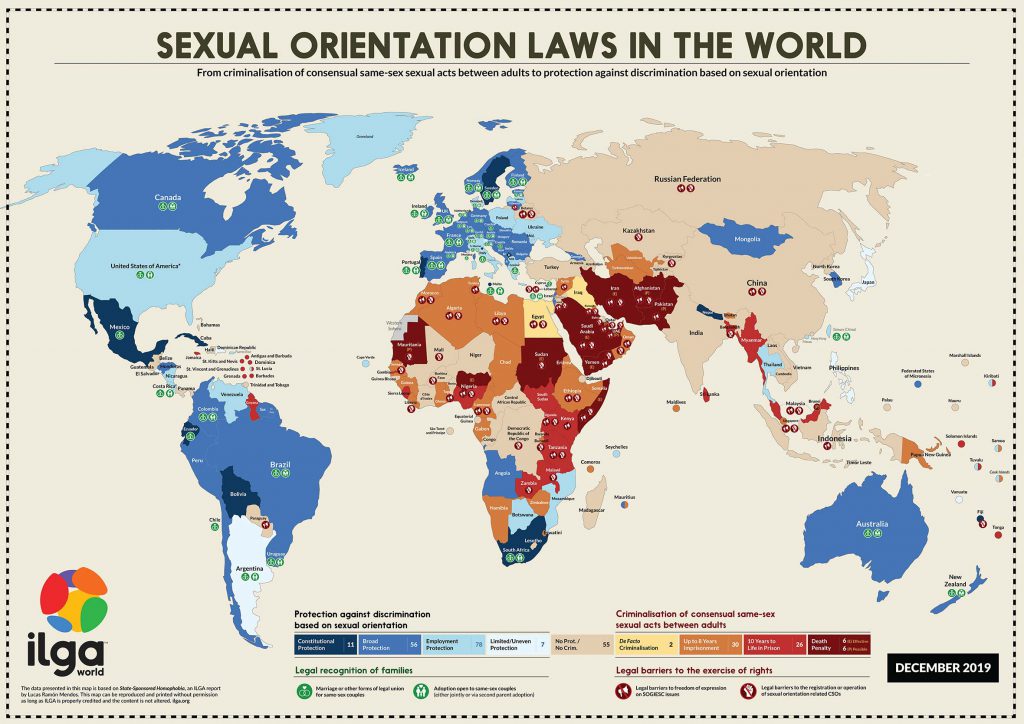
Source: ILGA World www.ilga.org
Answers to quiz in ACTION 3: Only #3, #8, #9 and #10 are FALSE
#3 FALSE.
Lesbians were not considered harmful to the regime and wore the black triangle as anti-social prisoners. There was no systematic persecution of lesbians that compared to the persecution of gay men.
#8 FALSE
Rosa Winkel is the German translation of ‘pink triangle’.
#9 FALSE
Homosexuals were considered to be criminals and were denied compensation. It wasn’t until 2001, that the German government recognized gays as victims of the Nazi regime. By that time, most of the men were very elderly or dead.
#10 FALSE
Gad Beck, the last known gay Jewish survivor, died on June 14, 2012.
Every effort has been made to gain permission from copyright holders to reproduce borrowed material. The publishers apologize for any errors and will be pleased to rectify them in subsequent reprints and website programming.
Educator Tools


